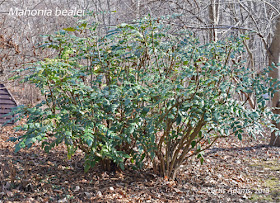You can read more about the toxicity of Nandina berries to birds in this post from Audubon Arkansas. You can mitigate this problem somewhat by planting more plants that bear fruit late in the season, particularly native species; but, you should not consider Nandinas as wildlife-friendly plants. If you want to use Nandinas for aesthetic purposes consider cultivars that do not produce berries such as 'Nana', 'Nana Purpurea', 'Atropurpurea Nana', or 'Gulf Stream.' These non-bearing cultivars are also less likely to spread outside the garden.
One of the species that I recommended in this article is Oregon Grape, Mahonia aquifolium, and other members of the genus. This broadleaf evergreen shrub is native to the Pacific Northwest, but is also found growing wild in some eastern states, most likely as a garden escapee. I thought I had some growing in my backyard, too. While researching this species I discovered that what I had was, in fact, Mahonia bealei, Leatherleaf Mahonia. This species, originally from western China, is listed as invasive in many of the same states as Nandina.
 |
| Here are two Leathrleaf Mahonia growing in a clump in late January. This species of shrub typically grows 4-10' in height, compared to 3-6' for the Northwest native Oregon grape. |
Learning that what I thought was Oregon Grape was actually a non-native species with invasive tendencies, I've decided to replace it with species native to this area. Even before this revelation I was considering replacing it with a more appropriate East Coast species. I would like to have an evergreen shrub that likes moist soils and open shade. Looking at my list of Nandina replacements for inspiration, I think I will go with Inkberry Holly, Ilex glabra, as the replacement. As with most hollies I will need both a male and a female plant to get berries for the birds. Fortunately there are both male and female cultivars available in the nursery trade so I will be able to start an inkberry family without too much trouble. As the male I will go with 'Nordic', a fairly compact species. There are more choices for the female. I would like them to grow to about 6 feet, so I have a choice of 'Compacta', 'Densa' or 'Nigra'.



No comments:
Post a Comment